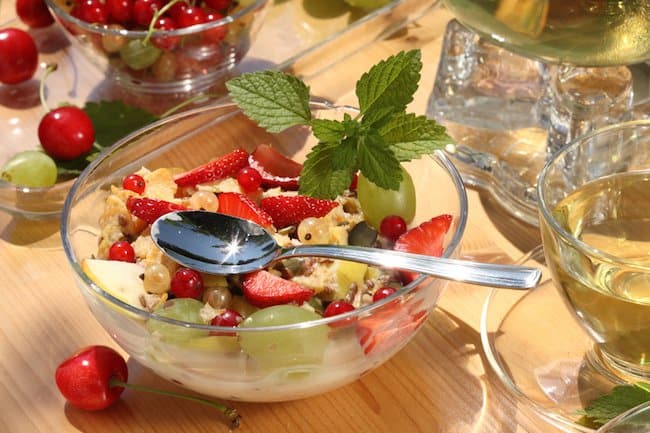
Breakfast cereals can be some of the most misleading food products when trying to determine the healthiest choice. Whilst many cereals are marketed as healthy options, or boast claims such as ‘low fat’, ‘high in B vitamins’ or ‘high in iron’, these claims often mask the real nutritional value of the product.
A cereal that is advertised as low fat, for example, may be high in sugar and therefore calories, so not really a healthy option. Breakfast cereals can be an important part of a healthy diet, and many studies have shown that those who eat breakfast are less likely to be overweight than those who do not. For this reason, it is important to know how to identify the healthiest options when choosing your breakfast cereal.
Important Nutrients
Fibre
Fibre is essential for a healthy digestive system, and is also thought to have a positive effect on heart health. High fibre foods are usually low GI, meaning that they are digested more slowly as the high fibre content slows the process in the intestines. This means that they result in a slower release of sugar into the blood stream, which can help keep you fuller for longer.
When choosing a breakfast cereal, aim to find one that contains at least three grams of fibre per serve, if possible more than five grams is ideal. Usually a high fibre cereal will fill you up more, so smaller serves may be sufficient.
Sugar
Many breakfast cereals have high sugar content, generally because this makes them more pleasant to eat, particularly for children. In general, it is recommendable to choose cereals which contain less sugar. The exceptions to this are cereals which contain dried fruit, as the natural fruit sugar will result in a higher overall sugar content. This does not make the cereal an unhealthy option as fruit also provides beneficial nutrients and fibre.
Aim to choose a cereal that has less than 5g of sugar or less than 25% of total calories per serving if it contains no fruit. It can also be helpful to read the ingredient list and avoid those cereals which list sugar near the top, as this means it is a prominent ingredient. Watch out for sugar under other names, such as high fructose corn syrup, honey, brown sugar, dextrose and glucose.
Fat
Many breakfast cereals are low in fat, but toasted cereals such as muesli can be reasonably high. Look for the cereal with the least fat per serving particularly saturated fat.
Whole Grains
Whole grains provide essential vitamins, minerals, protein and fibre and cereals based on these are the best choice. Many cereals these days are fortified with vitamins and minerals, but based on refined grains. Whilst these are better options than unfortified varieties, it is always best to go with a whole grain option if you can.
Calories
If you are counting calories, it is advisable to choose cereals with less than 120 calories per serve. By choosing varieties low in fat and sugar, you will often be choosing the lowest calorie option. Remember, some cereals may contain slightly more calories due to fruit or nuts, but can still be healthy options that contribute more nutrition to your diet.
When choosing a cereal it is essential to compare like with like, as the serving size varies greatly from cereal to cereal. Make sure you are comparing the same amount of cereal, or the amount you are planning on eating of each cereal to get the true nutrition comparison.
There are a huge number of ready to eat cereals available in the US, with new varieties hitting the shelves every day. To choose the best option for you it is important to read nutrition labels and compare brands. Below we have listed ten cereals that are high in fibre, as well as low in sugar, fat and calories.
Ten Healthy Cereal Choices (in no particular order)
1. General Mills Cheerios
Serve size 1 cup
Per serve: 3g fibre, 1g sugar, 103 calories
This low calorie classic does not have a huge amount of fibre, but is very low in sugar and fat, making it a good choice. Add some fresh fruit or mix with a bran based cereal for extra fibre.
2. Kashi Go Lean
Serve size 1 cup
Per serve: 10g fibre, 6g sugar, 148 calories
This cereal is packed full of fibre and contains seven whole grains. Producers claim in contains no artificial ingredients.
3. General Mills Fibre One
Per serve: 14g fibre, 0g sugar, 60 calories
Although this one is a bit of an acquired taste, it does contain very few calories, no suagr and a lot of fibre. The serve size may seem small, but you probably won’t be able to eat much more of this anyway due to the density of a cereal packed with so much fibre. Try mixing it with a lighter cereal for a more palatable option.
4. Kellogg’s All-Bran Buds
Per serve: 13g fibre, 8g sugar, 75 calories
A very high fibre option that provides about 25% of recommended daily iron requirement in one serve.
5. Kellogg’s All-Bran Original
Per serve: 9g fibre, 5g sugar, 81 calories
A high fibre choice that is fairly dense, therefore filling you up with a smaller portion. The taste is fairly bland, so mix with other cereals or add fruit and low fat yogurt to make it more interesting. This is also fortified with high levels of iron.
6. Post Raisin Bran
Per serve: 7g fibre, 17grams sugar, 187 calories
A whole grain cereal fortified with vitamins and minerals. This choice is higher in sugar, but this is predominately due to the presence of dried fruit.
7. Post Shredded Wheat Original
Per serve: 6g fibre, 0.5 g sugar, 167 calories
A very low sugar alternative that is made from 100% whole-grain wheat. It also has no added sodium, making it a very healthy choice.
8. Quaker Life Cereal (plain)
Per serve: 2g fibre, 6g sugar, 119 calories.
This cereal is made from whole grain oats and is also high in B vitamins and low in calories.
9. Kellogg’s Frosted Mini Wheats
Per serve: 6g fibre, 12g sugar, 200 calories
With whole grains as the first ingredient, these are nutritious and high in fibre. For the generous portion size, the calories and sugar contents are reasonable, making it one of the healthier choices for those with a sweet tooth. Try mixing with a lower sugar cereal to reduce the sugar percentage a little.
10. Kashi Heart to Heart Honey Toasted Oat Cereal
Per serve: 5g fibre, 5g sugar, 110 calories
This is an oat based cereal with a high content of oat flour and bran. A pleasant tasting cereal, that is higher in fibre than cereals such as Cheerios, but also slightly higher in sugar.
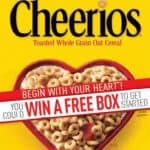
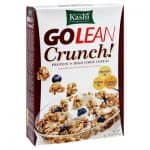
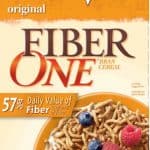
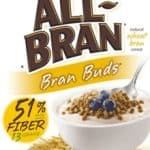
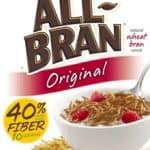
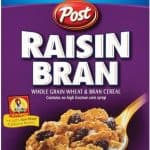
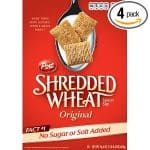
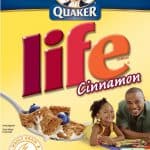
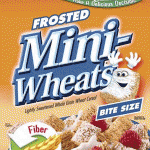
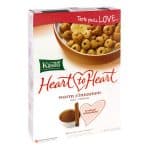
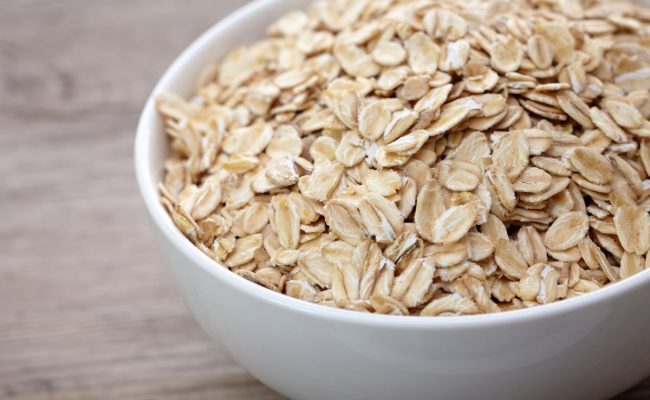
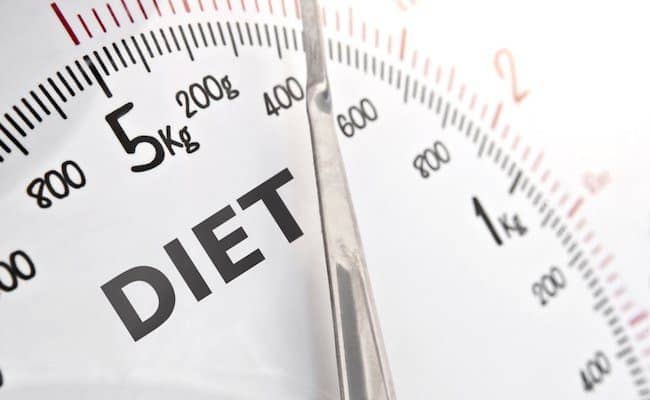

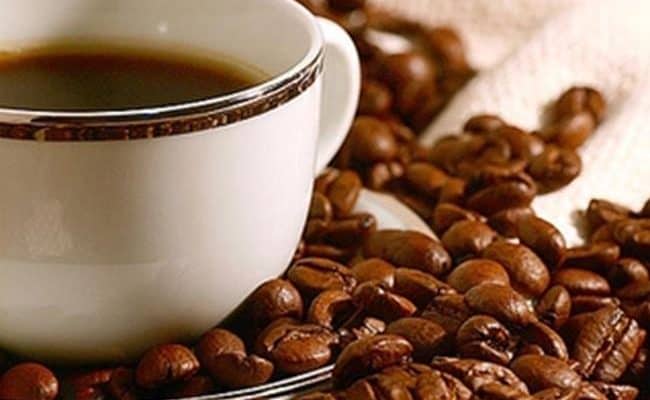
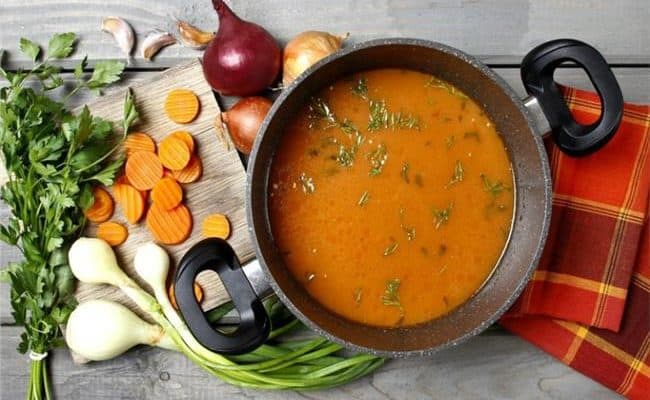
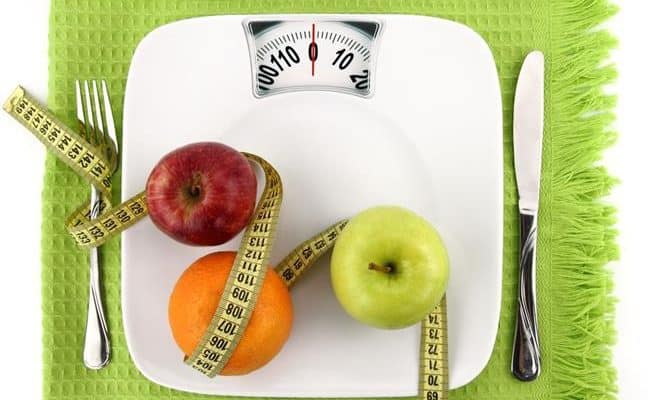





Kim Siever says
“This choice is higher in sugar, but this is predominately due to the presence of dried fruit.”
Dried fruit coated with sugar.
Sick O'Dieting says
Hi,
I just found your blog and your list. Funny that you should list General Mills’ Fiber One Original as your #3 top choice. Take a second look at the nutritional label, as I just did.
It says that one serving is 1/2 cup and it has 60 calories. Now, the fun begins: The label says that there is one gram of fat in each serving (there are nine calories in one gram of fat. So, we’re up to 9 calories.) The label says there are 25 grams of carbohydrates (there are four calories in each carbohydrate gram, so that makes 100 calories). And there are 2 grams of protein (again four calories in each gram of protein, so that is another 8 calories.)
Now, I am no dietician or nutritionist, I am just a mom of three kids who is sick of reading every label like a hawk. I am getting 9+100+8=117 calories, not 60! So, either General Mills has doubled the reported nutritional values or halved the calories. Either way, General Mills’ label on Fiber One Original Cereal is deceptive and misleading.
Mrs. B
Alex says
Hi
Thanks you for the very interesting question…
Your calculations are correct and the label is also correct! Let me explain:
The label for “General Mills fiber one” among other things gives the total number of calories 60, total carbohydrates 25.0g and dietary fiber 14.2.
Calories 60 Calories
Total Carbohydrates 25.0g
Dietary Fiber 14.2g
When calculating calories, fiber does not count in calories. So it’s 25-14.2 = 10.8gr of carbohydrates or 43.2 calories (10.8×4)
Re-doing your calculation 9+43+8=60 calories which is the number displayed on the label.
So their label is correct and given it’s other ingredients in terms of nutrition it deserves to be in the top 10 list.
Please note that the above clarification was provided by our associates Hara Hagikalfa (Health and exercise science) and Dr Adrian Slee (Senior lecturer of human nutrition and biochemistry and registered Nutritionist)
You can also read https://www.caloriesecrets.net/how-to-read-nutrition-labels-for-weight-loss-and-health/ and
https://www.caloriesecrets.net/how-much-fibre-should-we-eat-in-a-day/ for more detailed information about food labels and fibre.
Hope this clarifies your questions
Alex.
Kelly says
Author stated no particular order, and as far as calories go I am not concerned about healthy calories especially since I have a very high metabolism I actually prefer cereals with a healthy dose of good calories.
Thanks for the list!
Chris Fautz says
Insoluble Fiber has no calories but is considered a carb. So Fiber One relly only has 11 net carbs. That’s 44 calories. 9 calories from fat.
Tracy says
Thanks for the list. I eat the all brand, definitely with yogurt and fruit. I will munch the buds in the evening if I need that crunch. I also found Fiber Active by Rolston. It is 60 Cal/1/2 C.; 1g fat; 25g carb.; 14g dietary fiber; 0g sugar; 100mg Calcium. Still pretty bland to taste.
ron says
Hi,
Really confused. Why does Cheerios show total carbs as 20g but another line has
other carbs 16g Does that mean 36 is total or what? I am trying to watch my carbs due to high glucose in blood test.
Kelsey says
That means 16 grams OF the total carbohydrate grams come from “other carbohydrate,” which means starch. 20g is the total carbohydrate grams for one serving size. 16g from starch, 3g from fiber, and 1g from sugar = 20g total carbohydrate. Fiber, sugar, and “other” (starch) are all under the carbohydrate category due to their molecular structures. 🙂
Taryn says
If you look on Kashi’s website their caloric content for 1 (serving) cup of their Go Lean Crunch is 200 calories, and only contains 9grams of fiber.
Larry says
Sad so many high sugar, high salt cereals make this list. Just shows that no one should be relying on store bought cereals to get a truly healthy breakfast. Some in the list are ok, but more than half should be ruled out completely.
Glee says
Try making your own hot cereal such as oatmeal add fruit for sweetness
Guillermo Beltran says
What about Post Great Grains Banana Nut Crunch? Thanks!
ali haider says
cool work done mr!
kazy says
This was a very helpful list. I must say. However, it would’ve been a lot more helpful had you listed the carbs. Carbs is sugar. Add that to the already listed sugar and you got a whole lot of sugar in these cereals. Contrary to the prevailing misguided and bad science of the US food pyramid and their unhealthy suggestions of what Americans should eat, fat is not the enemy – sugar is. Fat is a more sustaining and healthy source of energy. Not carbs=sugar. That’s why it is important to eat high fiber foods because it slows down the carbs digestion. But if you’re going to calculate how much sugar your body is taking in, you have to know both the carbs and the sugar listed on these boxes so you have all the information in determining how healthy these cereals really are. Personally I wish they would just delete the sugar altogether and I’d add my own Stevia to it, rather than relying on these food manufacturers poisoning me with all that sugar (fructose).
Lisa says
I looking for something I can use as a breading for baked chicken, fish, etc. I need something low in calories. Anyone know of a low calorie cereal I could use to make my own breading that would have less calories than even panko.